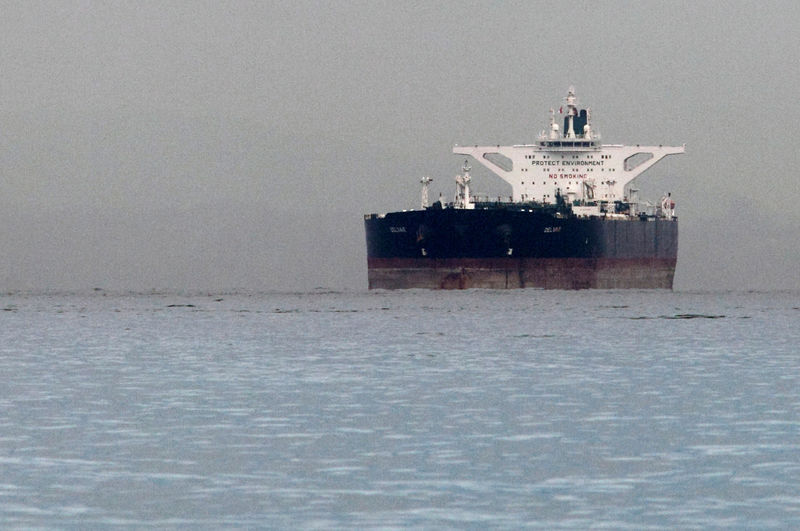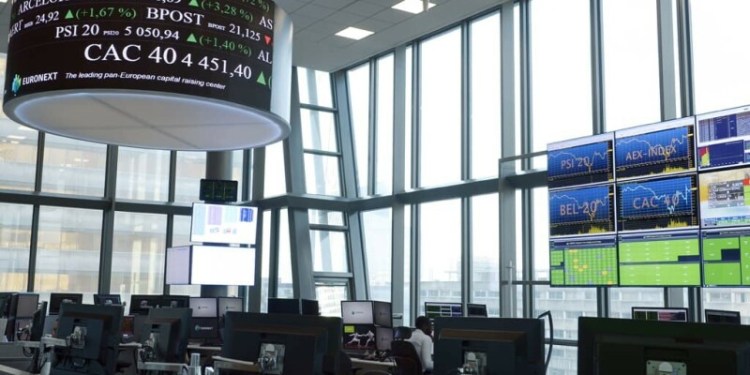 © Reuters. FILE PHOTO: Iranian crude oil supertanker “Delvar” is seen anchored off Singapore
© Reuters. FILE PHOTO: Iranian crude oil supertanker “Delvar” is seen anchored off SingaporeBy Amanda Cooper
LONDON (Reuters) – Two of Iran’s biggest OPEC rivals, Saudi Arabia and Iraq, are bagging its European oil market share by cranking up production of their lookalike crude grades before the restart of U.S. sanctions designed to halt exports from the Islamic Republic.
Iran faces curbs on its energy sector from early November after U.S. President Donald Trump walked away in May from a 2015 deal aimed at restraining Tehran’s nuclear program.
Iran’s crude is mainly bought by refiners in China, India, Japan and South Korea, although it has customers in Turkey and the European Union. Buyers seeking an alternative cannot simply opt for any crude on the market.
“As oil sanctions against Iran take effect, perhaps in combination with production problems elsewhere, maintaining global supply might be very challenging and would come at the expense of maintaining an adequate spare capacity cushion,” the International Energy Agency warned recently. [IEA/M]
“Thus, the market outlook could be far less calm at that point than it is today,” the Paris-based IEA said.
A senior Iranian diplomat told producer group OPEC on Aug. 19 that no member country should be allowed to take over another’s share of oil exports, in light of Saudi Arabia’s offer to produce more to cover any Iranian shortfalls.
But a look at trade flows shows that in Europe at least, Saudi Arabia and Iraq have already succeeded in doing so.
Since the start of the year, Iranian flows to Europe have fallen 35 percent to around 415,000 barrels per day (bpd), while Saudi shipments have doubled and those from Iraq have risen 30 percent, according to Reuters flows and ship-tracking data.
“Saudi, Basra, Urals,” one refiner said when asked what crude grades were likely alternatives, the latter two hailing from Iraq and Russia respectively.
Iraq and Saudi Arabia have raised their oil output by a combined 245,000 bpd since the start of the year and cut the official selling prices for their light crudes for customers in Asia.
Iran is the world’s fifth-largest oil exporter and with as much as 1.5 million bpd of supply estimated to be under threat, its customers may be forced to pay handsomely for possible replacements.
SWEET AND SOUR
Crude oil is categorized mainly according to sulfur content and its density relative to water, or American Petroleum Institute gravity. The denser crude is, the lower its gravity.
Crudes that have an API gravity above 35 degrees are categorized as “light”, while those with API gravity between 25 and 35 degrees are “medium” and below 25 degrees, “heavy”.
The lighter the crude, the easier and cheaper it is to extract and transport and the simpler it is to refine. Heavier crudes, which contain more impurities such as sulfur or metals, require additional processing to recover higher-value products.
Sulfur content is a second key category. A “sweet” crude is one with a sulfur content of less than 0.5 percent, while the sulfur content of a “sour” crude is above this threshold. Sulfur is corrosive and refineries that run more sour grades require more intense maintenance.
The average API for OPEC’s crudes is 33, compared with an average of 35.7 for U.S. grades. Shale, the fastest-growing type of , is lighter still.
(Graphic: Major crude oil grades by type – https://reut.rs/2OH67XX)
Iran Light is a medium sour crude, meaning that shale, however abundant and cheap, cannot act as a replacement on its own. Most refineries worldwide are tooled to run crudes with an API of 32, according to one source at a major European refiner.
(Graphic: EIA diagram of a conventional oil refinery – https://reut.rs/2L0yii9)
Refineries regularly blend different types of crude to get as close as possible to their optimal intake.
(Graphic: Major international crude oil grades – https://reut.rs/2OUtWeI)
The impact on the more sour crudes is already apparent. Prices for physical barrels oil have generally declined over the second half of this year, but Russian Urals, British Forties and Angolan Girassol, all sour, are the top-performing grades from around the Atlantic Basin, having lost around 4 percent.
That compares with losses of 5-6 percent for lighter, sweeter crudes such as Norwegian Ekofisk or Nigeria’s Bonny Light.
(Graphic: Sanctions on Iran’s crude exports spur race for market share – https://reut.rs/2Mw9nsk)
Source: Investing.com





























